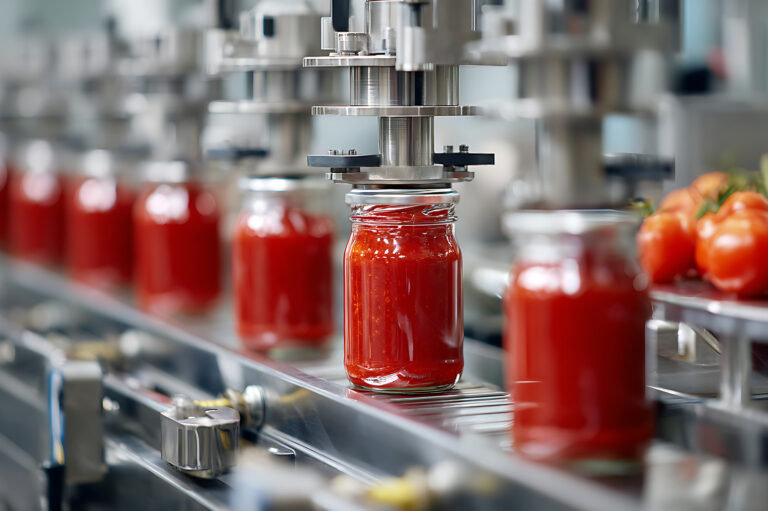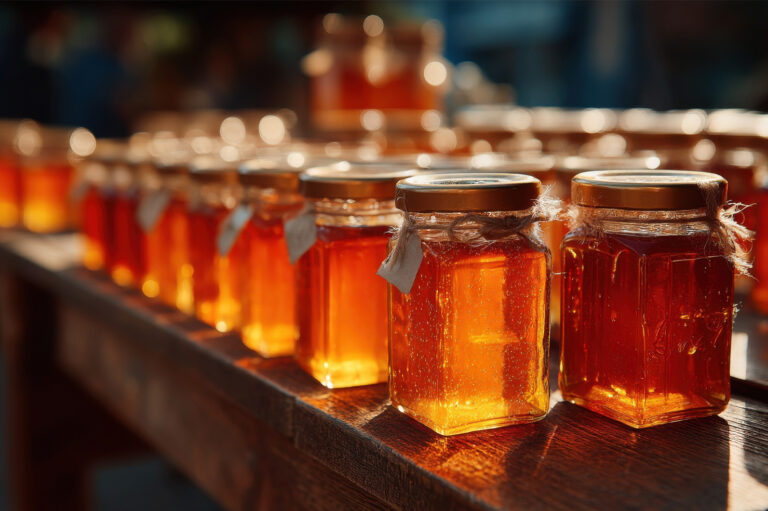A single contamination incident can destroy years of brand building. Ask any manufacturer who’s faced a product recall – the costs go far beyond replacing stock. Lost retailer confidence, regulatory scrutiny, and damaged consumer trust create financial impacts that extend for years.
Most UK food manufacturers understand packaging matters. What they don’t grasp is how precise the compliance requirements have become.
BRCGS – The Retail Gatekeeper
BRCGS certification opens doors. Without it, major retailers won’t even return your calls. This isn’t regulatory theatre – over 3,500 sites worldwide hold BRCGS certification because the alternative is commercial exile.
The Packaging Materials Standard Issue 6 demands documented hazard analysis for everything that could contaminate your product. Glass containers face scrutiny around heavy metal migration, thermal shock failure, and chemical leaching during high-temperature processing.
Paperwork requirements can overwhelm smaller operations. You need migration test certificates, statistical process control data, and detailed corrective action records. Miss any element and certification audits become expensive learning experiences.
Your supplier’s certification status determines your market access. No BRCGS means no Tesco, no Sainsbury’s, no major foodservice contracts.
EU Rules Still Apply Post Brexit
Brexit changed the politics, not the chemistry. UK food contact laws mirror EU Regulation 1935/2004 because science doesn’t respect borders. Two rules govern glass packaging: don’t poison customers, don’t ruin food quality.
Proving compliance requires migration testing, thermal stress analysis, and chemical composition verification. Commission Regulation 2023/2006 adds manufacturing standards – documented quality systems, contamination controls, and approved raw materials.
Cut corners at your peril. Regulatory investigations cost more than prevention.
Strict Heavy Metal Limits
EU Directive 84/500/EEC sets non-negotiable limits for lead and cadmium migration. Exceed these and your product becomes unsellable across Europe.
Lead Migration – Maximum Allowed:
- Large containers (over 3 litres): 1.5 mg/L
- Medium containers (0.3-3 litres): 2.5 mg/L
- Small containers (under 0.3 litres): 4.0 mg/L
Cadmium Migration – Maximum Allowed:
- Large containers: 0.1 mg/L
- Medium containers: 0.2 mg/L
- Small containers: 0.3 mg/L
Current limits won’t last. EFSA has advised that existing tolerances inadequately protect consumers. Tighter restrictions are coming within three years, so plan accordingly.
France enforces stricter standards with additional limits for antimony (0.04 mg/L), arsenic (0.02 mg/L), and chromium (0.05 mg/L). If you are planning to export to France, these become your problem too.
When Glass Breaks Under Thermal Shock
Glass containers crack during hot-fill processing when thermal stress exceeds material limits. Imagine dropping an ice cube into boiling water, – glass experiences similar trauma when temperature changes too rapidly.
Standard soda-lime glass tolerates roughly 40°C temperature differential before failure. Hot-filling at 85°C into containers stored at 20°C pushes close to breaking point.
Real-World Temperature Tolerances:
- Basic soda-lime glass: 40°C maximum differential
- Food packaging grade glass: 60-80°C working range
- Borosilicate glass: 166°C maximum differential
Manufacturers using jam jars for hot-fill operations need minimum 60°C thermal shock resistance. This provides adequate safety margin for processing temperatures reaching 85°C.
ASTM C149-86 testing cycles containers between hot and cold water until failure occurs. Simple methodology, but results determine whether production runs smoothly or becomes costly chaos.
Why HMRC Watches Container Capacity
Container capacity accuracy extends beyond customer satisfaction. Alcoholic products face particular scrutiny because duty calculations depend on precise volumes.
Legal Capacity Tolerances:
- Spirit bottles: ±1.5% (HMRC watches these closely)
- Wine bottles: ±3% under 100ml, ±6ml for 100-200ml containers
- Beer bottles: ±4% maximum deviation
Glass spirit bottles receive closest attention because systematic under-filling triggers investigations, penalties, and uncomfortable meetings with tax officials.
Professional glass manufacturers maintain ±2% capacity variation through statistical control – comfortably within legal limits whilst preserving production efficiency.
Getting Closure Compatibility Right
Container performance depends entirely on closure effectiveness. Poor sealing leads to contamination, spoilage, and expensive customer complaints.
Twist off caps require neck finishes within ±0.1mm tolerance for reliable performance. Modern manufacturing achieves this precision routinely.
Critical Neck Finish Dimensions:
- 28mm ROPP finish: 28.0mm ±0.15mm diameter
- 26mm crown finish: 26.0mm ±0.1mm diameter
- 82mm twist-off: 82.5mm ±0.2mm for preserve applications
The Consumer Protection Act 1987 mandates tamper evidence for many food products. Vacuum retention testing verifies seals maintain integrity throughout shelf life – typically 18 months under accelerated aging conditions.
Understanding Glass Chemistry Requirements
Glass composition directly affects safety and performance. Food-grade soda-lime glass must meet strict chemical specifications:
Maximum Allowed Concentrations:
- Lead content: 100 ppm maximum
- Antimony oxide: 0.3% by weight maximum
- Arsenic: 0.1 ppm maximum
- Chromium: 200 ppm total maximum
These limits exist because heavy metals accumulate in human tissue. Lead disrupts neurological development, particularly in children. Antimony causes gastrointestinal disorders. Arsenic… well, arsenic kills.
ISO 7459:1984 specifies testing methods ensuring these limits are met consistently throughout production.
How Testing Protocols Prove Safety
Migration testing replicates real-world conditions to verify packaging safety:
Standard Test Conditions:
- Temperature: 40°C for general contact, 70°C for hot-fill
- Duration: 10 days simulating long-term storage
- Test media: 10% ethanol for alcoholic products, 3% acetic acid for acidic foods
Internal pressure testing per ASTM C147-86 determines burst strength. Carbonated beverage containers must withstand minimum 150 psi – adequate for pressure buildup during distribution.
Impact testing uses calibrated weights to replicate handling damage. Tests focus on vulnerable areas like bottle shoulders and jar heels where impacts typically occur.
Extra Scrutiny for Alcoholic Products
Alcoholic beverages face heightened requirements due to duty implications and public health concerns.
Alcohol Strength Tolerances:
- Spirits: ±0.3% ABV maximum deviation
- Wine/beer up to 5.5% ABV: ±0.5% tolerance
- Beer/cider above 5.5% ABV: ±1% tolerance
HMRC demands systematic alcohol strength monitoring with documented corrective actions when products consistently exceed declared strength. Glass bottles for alcoholic products require particularly precise capacity control because duty calculations depend on accurate volume measurements.
Making Quality Systems Work in Practice
You can have perfect procedures on paper, but if your warehouse team doesn’t check containers properly, you’ll still get problems. Here’s what actually matters when glass containers arrive at your facility.
Check the basics that break production:
- Measure key dimensions – neck diameter, height, capacity. If these are wrong by more than 1%, your filling lines won’t work properly
- Look for cracks, chips, or bubbles that could cause containers to fail during processing
- Verify the supplier’s certificates actually match what you ordered, not just tick a compliance box
Use sampling for testing:
Instead of checking every single container (impossible) or randomly grabbing a few (unreliable), follow proven sampling methods. Check enough containers to catch real problems without slowing down operations.
For serious defects that would stop your production line, like wrong neck sizes or major cracks, aim to catch 99.6% of problem batches. For minor cosmetic issues that look bad but won’t cause operational problems, like small scratches, catching 97.5% of problem batches is sufficient.
Test with your actual products, not laboratory samples:
Don’t just rely on supplier test reports using water or standard test liquids. Fill containers with your product – your jam, your sauce, your beverage. Process them at the temperatures you actually use. Store them for the time periods your customers will experience.
Why? Because your acidic tomato sauce might react differently than neutral test liquid. Your hot-fill temperature might stress glass in ways laboratory testing missed. Your six-month shelf life might reveal seal failures that three-day tests didn’t show.
Environmental Obligations You Cannot Ignore
Extended Producer Responsibility isn’t optional anymore. Manufacturers now carry financial responsibility for packaging waste from cradle to grave. Glass wins this game because it recycles infinitely; plastic degrades, glass doesn’t.
Weight reduction programmes matter beyond environmental virtue signalling. Lighter packaging cuts transport costs, reduces carbon footprint, and satisfies sustainability reporting requirements. Modern engineering techniques slash 10-15% from container weight without compromising performance.
Carbon reporting has teeth now. Companies must document environmental impact from raw material extraction through end-of-life disposal. Glass performs strongly here thanks to high recycling rates and energy recovery potential, but documentation requirements are becoming Byzantine in complexity.
Managing Suppliers to Control Risk
Supplier relationships determine your compliance success. BRCGS certification is table stakes – without it, don’t waste time on introductory meetings. ISO 9001 quality systems matter, but technical support capability matters more. Can they solve problems at 2am when your production line stops?
Annual audits keep everyone honest. Schedule them religiously, document findings meticulously, and follow up corrective actions ruthlessly. Good suppliers welcome scrutiny because it demonstrates professionalism. Suppliers who resist auditing are telling you something important.
Supply chain transparency has evolved from nice-to-have to commercial necessity. Sustainability reporting, risk management, and regulatory compliance all depend on understanding your suppliers’ operations. Demand comprehensive documentation covering material sources, production methods, and environmental impact. Suppliers who cannot provide this data are living in the past.
What Future Regulations Will Demand
Digital Product Passports may become mandatory by 2027, demanding comprehensive tracking of environmental impact and material composition throughout supply chains.
Migration testing requirements continue expanding with new methods under development for nanomaterials and endocrine-disrupting chemicals. Glass packaging’s chemical inertness provides natural advantages as testing becomes more stringent.
BRCGS Issue 7 arrives in 2026 with enhanced requirements for supply chain transparency, environmental reporting, and digital traceability systems.
The Commercial Reality
Glass packaging delivers superior regulatory compliance, product protection, and consumer appeal, but only when specified correctly. Understanding precise requirements, testing protocols, and documentation standards determines success.
Investment in proper specification and supplier qualification pays dividends through reduced regulatory risk, enhanced product quality, and stronger consumer confidence. Working with experienced suppliers provides access to technical expertise necessary for navigating complex requirements whilst optimising commercial outcomes.
Prevention costs less than correction. Much less.

Pattesons Glass Ltd
Blossom Avenue, Hewitts Business Park,
Humberston, N.E. Lincolnshire, DN36 4TQ


